
A neonate gray whale calf, born just hours before, still exhbiting embryonic folds in the skin along its side. This baby gray whale was born in the cold waters of Big Sur, far to the north of the Mexican lagoons of Baja California where most gray whale births take place.
Species: Gray whale, Eschrichtius robustus
Location: Monterey, California
Image ID: 01135
Species: Gray whale, Eschrichtius robustus
Location: Monterey, California
Image ID: 01135

A blue whale eating krill. This blue whale is seen feeding and surfacing amid krill with its throat fully engorged with krill and water. It will push the water back out with its tongue, trapping the krill in its baleen which acts like a filter. Aerial photo, Baja California.
Species: Blue whale, Balaenoptera musculus
Image ID: 05837
Species: Blue whale, Balaenoptera musculus
Image ID: 05837

A great white shark swims just below the rippled ocean surface of Isla Guadalupe, far offshore of the Pacific Coast of Baja California.
Species: Great white shark, Carcharodon carcharias
Location: Guadalupe Island (Isla Guadalupe), Baja California, Mexico
Image ID: 07721
Species: Great white shark, Carcharodon carcharias
Location: Guadalupe Island (Isla Guadalupe), Baja California, Mexico
Image ID: 07721

Barspot Cardinalfish, Apogon retrosell, Sea of Cortez.
Species: Barspot Cardinalfish, Apogon retrosell
Location: Islas San Lorenzo, Baja California, Mexico
Image ID: 40442
Species: Barspot Cardinalfish, Apogon retrosell
Location: Islas San Lorenzo, Baja California, Mexico
Image ID: 40442
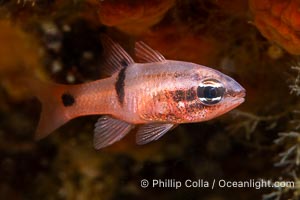
Barspot Cardinalfish, Apogon retrosell, Sea of Cortez.
Species: Barspot Cardinalfish, Apogon retrosell
Location: Islas San Lorenzo, Baja California, Mexico
Image ID: 40445
Species: Barspot Cardinalfish, Apogon retrosell
Location: Islas San Lorenzo, Baja California, Mexico
Image ID: 40445

Inquisitive young California sea lion underwater inspects my glove by gently mouthing it. This is a pup-of-the-year born in June and only about five months old. Sea lions are tactile creatures and learn about objects and their surroundings by biting on them. Coronado Islands near San Diego, Baja California, Mexico.
Species: California sea lion, Zalophus californianus
Location: Coronado Islands (Islas Coronado), Baja California, Mexico
Image ID: 40767
Species: California sea lion, Zalophus californianus
Location: Coronado Islands (Islas Coronado), Baja California, Mexico
Image ID: 40767

Longnose hawkfish on black coral, underwater, Sea of Cortez, Baja California.
Species: Black coral, Longnose hawkfish, Antipatharia, Oxycirrhites typus
Location: Baja California, Mexico
Image ID: 33616
Species: Black coral, Longnose hawkfish, Antipatharia, Oxycirrhites typus
Location: Baja California, Mexico
Image ID: 33616

Aerial photo of Islas San Lorenzo in the Sea of Cortez. San Lorenzo Marine Archipelago National Park is a national park of Mexico located on San Lorenzo Island part of an archipelago in the Gulf of California off the eastern coast of Baja California. The San Lorenzo Archipelago is considered one of the most important ecological areas of the Gulf of California. The Island and surrounding areas are part of a rich ecosystem comprised by a grand variety of flora and marine fauna. This area is protected by the Mexican federal government Norma Oficial Mexicana because of its importance as a habitat for several endangered species.
Location: Islas San Lorenzo, Baja California, Mexico
Image ID: 40441
Location: Islas San Lorenzo, Baja California, Mexico
Image ID: 40441
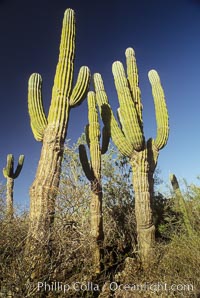
Cardon cactus, near La Paz, Baja California, Mexico. Known as the elephant cactus or Mexican giant cactus, cardon is largest cactus in the world and is endemic to the deserts of the Baja California peninsula. Some specimens of cardon have been measured over 21m (70) high. These slow-growing plants live up to 300 years and can weigh 25 tons. Cardon is often mistaken for the superficially similar saguaro of Arizona and Sonora, but the saguaro does not occupy Baja California.
Species: Cardon cactus, Elephant cactus, Pachycereus pringlei
Location: La Paz, Baja California, Mexico
Image ID: 05498
Species: Cardon cactus, Elephant cactus, Pachycereus pringlei
Location: La Paz, Baja California, Mexico
Image ID: 05498

Cardon Cactus on Isla San Jose, Aerial View, Baja California.
Species: Cardon cactus, Elephant cactus, Pachycereus pringlei
Location: Isla San Jose, Baja California, Mexico
Image ID: 33688
Panorama dimensions: 3155 x 8689
Species: Cardon cactus, Elephant cactus, Pachycereus pringlei
Location: Isla San Jose, Baja California, Mexico
Image ID: 33688
Panorama dimensions: 3155 x 8689

Cardon Cactus on Isla San Diego, Aerial View, Baja California.
Species: Cardon cactus, Elephant cactus, Pachycereus pringlei
Location: Isla San Diego, Baja California, Mexico
Image ID: 33575
Species: Cardon cactus, Elephant cactus, Pachycereus pringlei
Location: Isla San Diego, Baja California, Mexico
Image ID: 33575

Beautiful underwater sunburst, glittering light through the ocean surface, Sea of Cortez, Baja California, Mexico.
Location: Sea of Cortez, Baja California, Mexico
Image ID: 27562
Location: Sea of Cortez, Baja California, Mexico
Image ID: 27562

Yellow-tailed surgeonfish schooling, Sea of Cortez, Baja California, Mexico.
Species: Yellow-tailed surgeonfish, Prionurus laticlavius
Location: Sea of Cortez, Baja California, Mexico
Image ID: 27564
Species: Yellow-tailed surgeonfish, Prionurus laticlavius
Location: Sea of Cortez, Baja California, Mexico
Image ID: 27564

Longnose Hawkfish on Black Coral, Oxycirrhites typus.
Species: Black coral, Longnose hawkfish, Antipatharia, Oxycirrhites typus
Location: Isla San Diego, Baja California, Mexico
Image ID: 33570
Species: Black coral, Longnose hawkfish, Antipatharia, Oxycirrhites typus
Location: Isla San Diego, Baja California, Mexico
Image ID: 33570

A great white shark swims just below the rippled ocean surface of Isla Guadalupe, far offshore of the Pacific Coast of Baja California.
Species: Great white shark, Carcharodon carcharias
Location: Guadalupe Island (Isla Guadalupe), Baja California, Mexico
Image ID: 07717
Species: Great white shark, Carcharodon carcharias
Location: Guadalupe Island (Isla Guadalupe), Baja California, Mexico
Image ID: 07717

Starfish Sea Star Detail, Sea of Cortez, Mexico.
Location: Isla Angel de la Guarda, Baja California, Mexico
Image ID: 40332
Location: Isla Angel de la Guarda, Baja California, Mexico
Image ID: 40332

Barspot Cardinalfish, Apogon retrosell, Sea of Cortez.
Species: Barspot Cardinalfish, Apogon retrosell
Location: Islas San Lorenzo, Baja California, Mexico
Image ID: 40443
Species: Barspot Cardinalfish, Apogon retrosell
Location: Islas San Lorenzo, Baja California, Mexico
Image ID: 40443
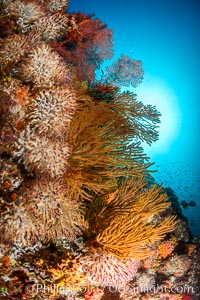
Underwater Reef with Invertebrates, Gorgonians, Coral Polyps, Sea of Cortez, Baja California.
Location: Mikes Reef, Baja California, Mexico
Image ID: 33494
Location: Mikes Reef, Baja California, Mexico
Image ID: 33494

King Angelfish, Sea of Cortez, Baja California.
Species: King angelfish, Holacanthus passer
Location: Isla San Diego, Baja California, Mexico
Image ID: 33528
Species: King angelfish, Holacanthus passer
Location: Isla San Diego, Baja California, Mexico
Image ID: 33528
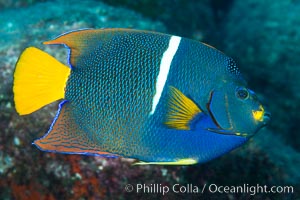
King Angelfish, Sea of Cortez, Baja California.
Species: King angelfish, Holacanthus passer
Location: Isla San Diego, Baja California, Mexico
Image ID: 33533
Species: King angelfish, Holacanthus passer
Location: Isla San Diego, Baja California, Mexico
Image ID: 33533

Coral Hawkfish, Sea of Cortez, Baja California.
Location: Isla San Diego, Baja California, Mexico
Image ID: 33557
Location: Isla San Diego, Baja California, Mexico
Image ID: 33557

Starfish Sea Star Detail, Sea of Cortez, Mexico.
Location: Isla San Diego, Baja California, Mexico
Image ID: 33558
Location: Isla San Diego, Baja California, Mexico
Image ID: 33558

Coral Hawkfish, Sea of Cortez, Baja California.
Location: Isla San Diego, Baja California, Mexico
Image ID: 33566
Location: Isla San Diego, Baja California, Mexico
Image ID: 33566
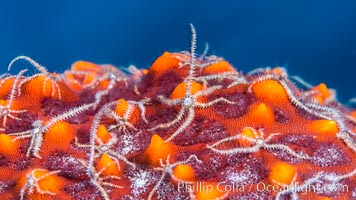
Minute starfish (sea star) living on larger starfish, Sea of Cortez, Mexico.
Location: Isla San Diego, Baja California, Mexico
Image ID: 33586
Location: Isla San Diego, Baja California, Mexico
Image ID: 33586

Minute starfish (sea star) living on larger starfish, Sea of Cortez, Mexico.
Location: Isla San Diego, Baja California, Mexico
Image ID: 33587
Location: Isla San Diego, Baja California, Mexico
Image ID: 33587

Coral Hawkfish, Sea of Cortez, Baja California.
Location: Isla San Diego, Baja California, Mexico
Image ID: 33592
Location: Isla San Diego, Baja California, Mexico
Image ID: 33592

Coral Hawkfish, Sea of Cortez, Baja California.
Location: Isla San Diego, Baja California, Mexico
Image ID: 33593
Location: Isla San Diego, Baja California, Mexico
Image ID: 33593
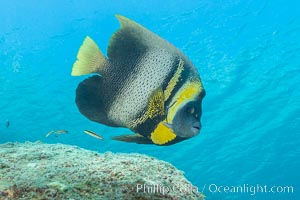
Cortez Angelfish, Pomacanthus zonipectus, Sea of Cortez, Mexico.
Species: Cortez Angelfish, Pomacanthus zonipectus
Location: Isla San Francisquito, Baja California, Mexico
Image ID: 33636
Species: Cortez Angelfish, Pomacanthus zonipectus
Location: Isla San Francisquito, Baja California, Mexico
Image ID: 33636

In the Shallows at Isla San Francisquito, Sea of Cortez.
Location: Isla San Francisquito, Baja California, Mexico
Image ID: 33638
Location: Isla San Francisquito, Baja California, Mexico
Image ID: 33638
